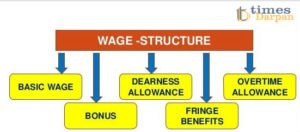The term wage incentive has been used both in the restricted sense of participation and in the widest sense of financial motivation.
Incentives are variable rewards granted to employees according to variations in their performance. The other name for incentives is ‘payment by result’. But the wage incentive is most appropriate because of its motivational content.
Definition of Wage Incentive
It has been defined differently by different authors. We give below a few of these definitions.
It is a term which refers to objectives in the external situation whose function is to increase or maintain some already initiated activities, either in duration or in intensity.
According to Hummel and Nicksons,”It refers to all the plans that provide extra pay refer for extra performance in addition to regular wages for a job.”
Florence observes: “It refers to increased willingness as distinguished from capacity. Incentives do not create but only aim to increase the national momentum towards productivity.”
In the words of scott, “It is only formal and announced programme under which the income of an individual, a small group, a plant workforce or all the employees of a firm are partially or wholly related to some measure of productivity output.
According to the national Commission of Labour, “Wage incentives are extra financial motivation. They are designed to stimulate human effort by rewarding the person over and above the time rated remuneration, for improvements in the present of targeted results.”
Objectives of Wage incentive Schemes
Wage incentive schemes aim at the fulfillment of one or more of the following objectives:
- To improve the profit of a firm through a reduction in the unit costs of labour and materials or both.
- To avoid or minimize additional capital investment for the expansion of production capacity.
- To increase a worker’s earnings without dragging the firm into a higher wage rate structure regardless of productivity.
- To use wage incentives as a useful tool for securing a better utilization of manpower, better production scheduling and performance control, and a more effective personnel policy.
Merits of wage Incentive Scheme
Such scheme are regarded as beneficial of both employers and workers. They are accepted as a sound technique for the achievement of greater production on the ground that workers would work at their best of they are offered monetary rewards for good performance.
Incentives may be regarded as a step in the direction of linking a worker’s compensation with his productivity – an important prerequisite of economic development.
Demerits of incentive Schemes
Some studies on the subject show that incentive schemes have a dubious value for increase in output. Even where an incentive scheme yields an increased output, it may generate tensions among the different parts of an organisation.
Such tensions often create difficult managerial problems and may eventually affect output. A sound and effective administration of incentive schemes would depend upon an understanding of the problems of human relations as well as those of engineering.
Need for Wage Incentives In India
The need for wage incentive schemes in India is felt due to the following reasons:
Reason 1: The efficiency of the Indian workers is very low, and needs to be raised. Wage Incentives can play an important part improving his efficiency.
Reason 2: The average Indian worker is financially very poor. Financial incentives therefore are likely to tempt him to work better.
Reason 3: India is at a low level of technology, and wage incentives can help in promoting the use of electronic devices.
Reason 4: A proper application of wage incentive schemes can so affect the prices that the community would be benefited.
Reason 5: In the national interest, it is felt that wage incentive schemes should be applied to all economic activities.

Wage Incentive plans
There are some important wage incentive plans are given below:
- Halsey Premium Plan
- Halsey-Weir Premium Plan
- Rowan Premium Plan
- The 100 per cent Premium Plan
- The Bedaux Point Plan
- Taylor’s Differential Piece rate Plan
- Merric’k Multiple piece rate Plan
- The Gantt task and Bonus plan
- Emerson Efficiency Plan
- Co-partnership system
- Accelerating premium systems
Plan 1: Hasley premium Plan
In Hasley Plan, bonus paid to a worker is equal to 50 per cent of time saved multiplied by rate per hour. This is time-saving bonus plan which is ordinarily used when accurate performance standards have not been established.
Under this plan, it is optional for a workman to work on the premium plan or not. The plan is a combination of the day wage and the piece wage in a modified form.
Formula: Bonus = 1/2 of Time saved/Time taken x daily wage
Plan 2: Hasley-Weir Premium Plan
This plan is similar to the hasley premium plan except that 50 per cent of the time saved is given as premium to the worker.
Bonus = ½ x Time saved x Hourly Rate
Plan 3: Rowan Premium Plan
In Rowan plan, bonus paid to the employee is equal to the proportion of the time saved to the standard time. This plan differs from the Hasley plan only in regard to the determination of the bonus.
In the Rowan Plan, the time saved is expressed as a percentage of the time allowed and the hourly rate of pay is increased by that percentage so that total earnings of the worker are the total number of hours multiplied by the increased hourly wages.
Formula : Bonus = Time saved/Time allowed x Time taken x Hourly rate
Plan 4: The 100 per cent Premium Plan
Under this plan, task standards are set by time study or work sampling, and rates are expressed in time rates rather than in money. A definite hourly rate is paid for each task-hour of work performed. The worker is paid the full value to the time saved.
The plan is identical with the straight piece-rate plan except for its higher guaranteed hourly rate and the use of task time as a unit of payment instead of a price per piece.
Plan 5: The Bedaux Point Plan
This plan is used when careful assessed performance standards have been established. It differs from the 100 per cent plan in that the basic unit of the time is the minute termed as B.every job is expressed in terms of bedaux point, which means that a job should be completed in so many minutes.
Under the Bedaux scheme, standard time for a job is fixed. Each minute of the standard time is called a point or Bedaux point. Each job has a standard number of bedaux point. The worker receives bonus which is equal to 75% of the number of points earned, in excess of 60 per hour, multiplied by one-sixtieth of the worker’s hourly rate.
Plan 6: Taylor’s Differential Piece rate Plan
In the Taylor’s differential piece rate system, an efficient worker (whose output exceeds standard output)is paid 120 per cent of the piece rate. An efficient worker(whose output falls short of standard) is paid only 80 per cent of the piece rate.
This system was introduced by taylor with two objects: first, to give sufficient incentive to workmen to induce them to produce up to their full capacity;and second, to remove the fear of wage cut.
Plan 7: Merric’k Multiple piece rate Plan
This system too is based on the principle of a low piece rate for a slow worker and a higher piece rate for higher productions.
Under the Merrick differential piece rate, straight piece rate is paid to the worker up to 83 per cent of the standards output, at which a bonus of 10 per cent of the time rate is payable, with a further 10 per cent bonus on reaching the standard output.
Plan 8: The Gantt task and Bonus plan
This plan has been devised by H.L. Gantt and is the only one that pays a bonus percentage multiplied by the value of standard time. Under this system, fixed time rates are guaranteed.
This system is most profitable for workers whose efficiency is very high. Under this plan, there are also three stages of payment:
- Below the standard performance, only the minimum guaranteed wage is to paid;
- At the standard performance, this wage +20% of time rate will be paid as a bonus
- Where the standard is exceeded, a higher piece rate is paid but them is no bonus.
Plan 9: Emerson Efficiency Plan
Under this system, a standard time is established for a standard task. They day wage is assured. There is no sudden rise in wage on achieving the standard of performance. The remuneration based on efficiency rises gradually. Efficiency is determined by the ratio between the standard time fixed for a performance and the time actually taken by a worker.
Plan 10: Co-partnership system
This system tries to eliminate friction between capital and labour. Under this system, not only does a worker share in the profits of the undertaking but he also takes part in its control and therefore, share responsibilities.
There are different degrees of this partnership and control allowed to the operatives in different cases; but in a complete system, the following factors are present.
- The payment of the existing standard wages of labour.
- The payment of a fixed rate of interest on capital.
- The division of the surplus profit between capital and labour in an agreed proportion.
- The payment for a part of the worker’s labour by the allotment of a share in the capital
- The sharing in the control of the business by the representatives of labour.
Plan 11: Accelerating premium systems
There are the systems which provide for a guaranteed minimum wage for output below standard. In this system, the production is pushed up higher and higher by discouraging low output and rewarding at an increasingly effective rate of higher outputs.
Such schemes are generally adopted when much higher outputs than what are currently obtained are to be achieved.
At last words, Wage Incentives is best process for an organisation to increase productivity because it is financial motivated to an employee for productivity. And it is safe because the wages policy in out country is governed by several legislative provisions and constitutional requirements.
Related Topic :-
- Importance of Human resources managers
- Steps to start small scale industries
- Why do workers Join trade union
Note :- For any quires of this article, you can comment us and For Contact with us you can like our Facebook page to and Subscribe to the YouTube channel.













